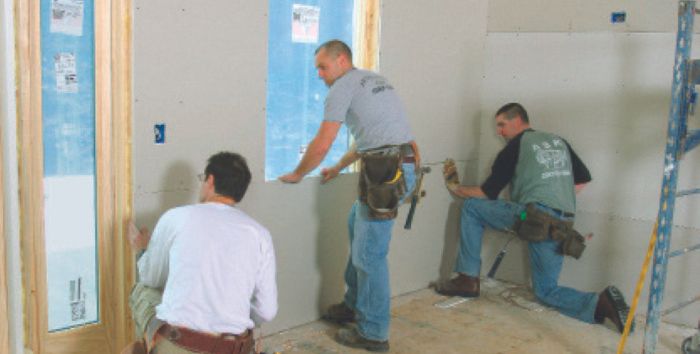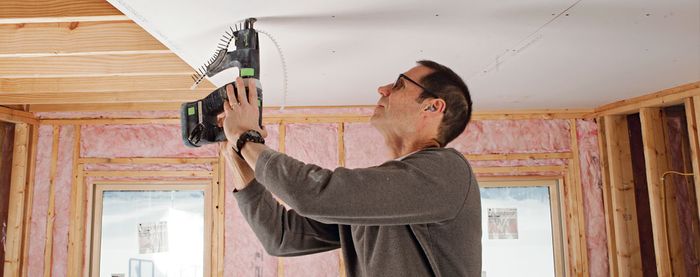Horizontal vs. Vertical Drywall: Which is Best?
Hanging drywall horizontally does place seams at a more convenient height for finishing, resulting in better work, but that’s only part of the story.

Myron R. Ferguson’s book, Drywall: Professional Techniques for Great Results, has many helpful ideas, but as a trim carpenter I was dismayed to see him promote hanging drywall horizontally. When the tapered bevel is placed on the floor, it makes fitting coped corners in baseboard much more difficult, as the baseboard is now “kicked in” at an angle. Also, when drywall is installed horizontally, you end up with an unsupported joint between each stud. If fastened vertically, every edge will land securely on a stud. I know it is easier for drywall installers to install and finish horizontally, but this method adds difficulty for trim carpenters, and I think adds weakness to the wall as well.
— David Ferrand, via email
Myron R. Ferguson: As far as the tapered edge along the base goes, attaching a shim along the floor is really the answer. Changing the orientation of the drywall will just create poorer-quality finished walls. Hanging drywall horizontally does, as you point out, place seams at a more convenient height for finishing, resulting in better work, but that’s only part of the story. When the walls are 9 ft. high or less, attaching the drywall horizontally can reduce the lineal footage of seams by as much as 25% over vertical attachment. When combined with the longest sheets possible, butt seams are minimized, and those that do appear land between studs where they can be back-blocked to make them easier to finish. The unsupported edges you mention aren’t a problem and are actually less likely to crack than a joint that lands on a stud. All of this adds up to a smoother wall. But the perks go beyond labor savings and quality of finish. Horizontal attachment actually increases the shear strength of the structure.
Fine Homebuilding Recommended Products
Fine Homebuilding receives a commission for items purchased through links on this site, including Amazon Associates and other affiliate advertising programs.

Original Speed Square

Smart String Line

100-ft. Tape Measure






View Comments
I've been in the carpenters union for eight years now and I've been doing drywall since the beginning. When placing the boards horizontal (if not 8' or 12' boards), in order to solve the riddle of a joint not landing on a stud. You simply have to cut the first board so that it lands center of the layout and all other boards will follow on layout.
Also, by ripping down the board and removing the tapered edge. It will help speed up the process for molding. Also save your back from bending over to putting on shims.
As a DIY remodeler doing drywall, it is much easier for me to finish the seams if the panels are installed vertically. That way, all the seams have tapered edges. I'm also working by myself, and I can only handle 8 foot sheets (and I can only navigate 8 foot sheets though the house to get to the room!). The added benefit is having untapered edges at the top and bottom.
So much easier with stand-ups. No intersecting horizontal and butt joints speed up taping tremendously. And anyone trying to talk about horizontal being stronger shear strength is trying to muddy the waters. Sheetrock is not intended to be structural. Nice try though.
You can’t believe everything you read on the internet. David Ferrand - you're absolutely right! Myron R. Ferguson - sorry buddy: you are absolutely wrong. Attaching a shim.... really? That's absolutely ridiculous & absurd. If you want a high end job & professional job you go vertical. Your comment that they ‘are actually less likely to crack than a joint that lands on a stud’ is just absolutely UNTRUE. There will NEVER be any cracks so long as you don’t put a piece of stud that is heavy/wet behind it or one with a grain pattern that will warp. Anyone thats a professional will understand exactly what I just mentioned about the grain of the stud. If you don’t understand that you shouldn’t be in the business! With metal it doesn’t matter. Everyone wants to keep up the hype about horizontal jobs because if every customer in the world new vertical drywall was a more professional & higher end job all these knuckleheads doing drywall business’ would have to pay more money out to their employees for the little extra time it takes to do the job vertical & to do it right. No job of mine has EVER cracked doing vertical but ALL DAY long I can take you places that have cracked horizontal seams. I just went into a house that just got done horizontal. Job is less than 6 months old. Guess what… CRACKED all the way around the place. So sad. Also your comment about strength is not true at all either. Its COMPLETELY relative to the quality of who did the frame - whether they where chintzy on how many studs they placed, whether the job is squared & level, whether glue was added, as well as whether screws vs nails were used. For most business’ these days they just do jimmy jobs to get paid the most. Hardly anyone cares about the customer or takes pride in their work.
You just proved yourself wrong in your first sentence! You have "your" opinion on how to hang drywall and that's fine. However, it doesn't make it "right" for everyone. I have inspected 1,000's of homes under construction and the overwhelming way to hang is horizontal. Cracks do not happen because drywall was hung horizontally, it happens because the job was done incorrectly.